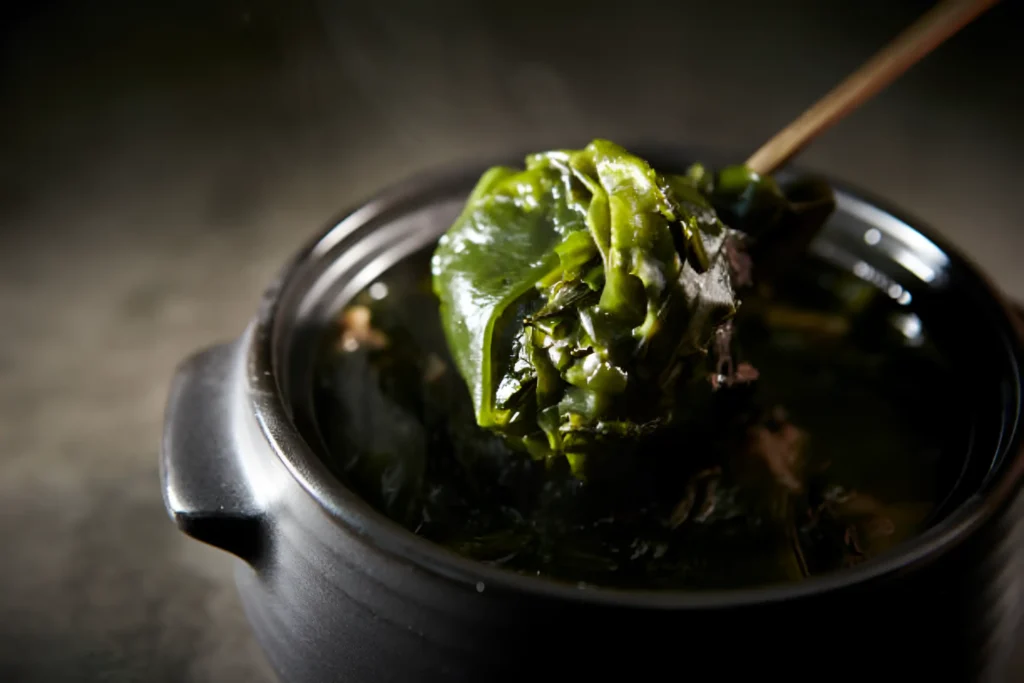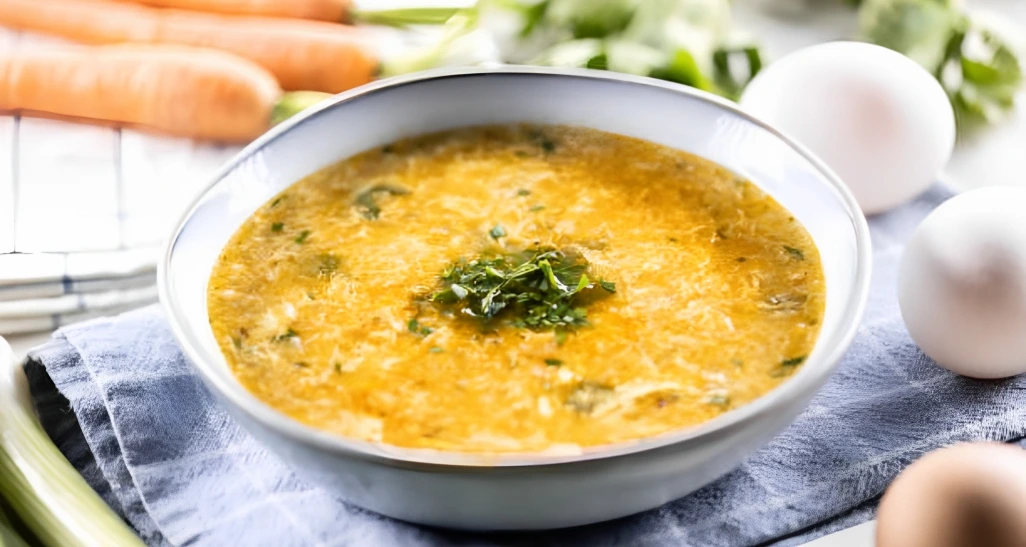Seaweed Soup: How to Make It in 25 Minutes Flat

Looking for a quick, healthy meal that brings Korean flavors to your table? Seaweed soup, or miyeok guk, is your answer. It turns your kitchen into a Korean spot in just 25 minutes. This shows that tasty meals can be ready fast.
Busy or just wanting to try new tastes? Seaweed soup is easy to make and full of flavor. You can whip up a real miyeok guk that’s both cozy and nutritious.
Key Takeaways
- Seaweed soup takes only 25 minutes to prepare
- Miyeok guk is a traditional Korean dish with deep cultural roots
- Perfect for health-conscious individuals seeking quick meals
- Requires minimal cooking skills
- Nutrient-dense recipe with versatile protein options
Understanding Korean Seaweed Soup (Miyeok Guk)
Seaweed soup in Korean cuisine is more than just food. It’s a tradition that holds deep cultural and personal meaning. Known as miyeok guk, it’s a special dish in Korean food culture and celebrations.
This soup has deep roots in Korean heritage. It connects generations through its simple yet powerful ingredients. For centuries, families have shared seaweed soup recipes, making it a meal full of emotional value.
Cultural Significance in Korean Cuisine
In Korean culture, miyeok guk is more than a meal. It stands for:
- Maternal love and care
- Healing and restoration
- Family heritage and connection
Traditional Birthday Celebration Dish
Seaweed soup is a big deal on Korean birthdays. Women eat it after giving birth, believing it helps them recover. It’s a way for children to honor their mother’s strength.
Nutritional Benefits of Miyeok Guk
Miyeok guk is packed with nutrients. The seaweed in it is full of minerals and vitamins that boost health. It’s also low in calories but high in nutrients, making it a great choice for your diet.
- Iodine: Supports thyroid function
- Calcium: Strengthens bones
- Iron: Enhances blood health
Exploring Korean cuisine or looking for a healthy meal? Seaweed soup is a tasty way to dive into culture and wellness.
Essential Ingredients for Perfect Seaweed Soup
Making a great seaweed soup needs the right ingredients. These ingredients add depth and nutrition to your dish. Knowing the key parts is key to making a memorable meal.
Your essential ingredients for a traditional seaweed soup include:
- Dried seaweed (wakame) – The star ingredient of any authentic kelp soup
- Beef or seafood broth for rich flavor
- Garlic and green onions for aromatic depth
- Soy sauce for umami complexity
- Sesame oil for finishing touch
When picking seaweed, choose high-quality options. Look for dark green, uniform sheets without discoloration. Asian grocery stores or online markets usually have the best selection.
If you can’t find specialty ingredients, don’t fret. Many grocery stores have international food sections. You can also use similar sea vegetables if you can’t find wakame.
It’s important to know how each ingredient works. Seaweed adds minerals and a unique ocean flavor. Proteins and aromatics add complexity. Try different mixes to find your favorite.
Choosing the Right Type of Seaweed
Choosing the right seaweed is key to making a tasty and authentic seaweed soup. The type of seaweed you pick can change the flavor and health benefits of your soup.
Exploring seaweed options can seem daunting. But knowing your choices will help you make a great kelp soup.
Dried vs Fresh Seaweed Options
When making seaweed soup, you’ll find two main types of seaweed:
- Dried Seaweed: Lasts longer and is easier to find
- Fresh Seaweed: Has a more delicate taste
Rehydrating Dried Seaweed
To rehydrate dried seaweed, follow these steps for the best texture:
- Soak seaweed in cold water for 5-10 minutes
- Gently squeeze out extra water
- Cut into small pieces
Quality Indicators
| Quality Indicator | What to Look For |
|---|---|
| Color | Deep green or dark brown |
| Texture | Smooth, not brittle or too crisp |
| Smell | Clean ocean scent, no musty smells |
“The quality of your seaweed determines the soul of your soup” – Korean Culinary Wisdom
Pro tip: Buy dried seaweed from trusted sources that focus on marine products. This ensures you get fresh and high-quality seaweed for your kelp soup.
Kitchen Tools You’ll Need
To make miyeok guk, you need some key kitchen tools. They help you make this Korean seaweed soup fast and well. The right tools make cooking easier and more fun.
- Large Pot: A 4-6 quart stockpot is key for miyeok guk. It lets ingredients simmer and get rich flavors.
- Sharp Knife: It’s for cutting seaweed, meat, and other ingredients with care.
- Cutting Board: Choose a wooden or plastic one for soup ingredients.
- Strainer: It’s for rinsing and draining seaweed before cooking.
- Measuring Cups and Spoons: They help you get the right amounts of ingredients.
With these basic tools, making miyeok guk is a breeze. Both pros and home cooks use them to make real Korean seaweed soup.
| Tool | Purpose in Miyeok Guk Preparation | Recommended Size/Type |
|---|---|---|
| Stockpot | Cooking soup base | 4-6 quart stainless steel |
| Knife | Ingredient preparation | 8-inch chef’s knife |
| Cutting Board | Safe ingredient chopping | Medium wooden board |
| Strainer | Seaweed rinsing | Fine mesh stainless steel |
You don’t need every tool to make miyeok guk. Many cooks use what they have. The main thing is knowing what you need to make tasty miyeok guk.
Preparation Steps Before Cooking
Making a true seaweed soup korean dish needs careful prep. Before cooking, make sure your ingredients are ready. This ensures a tasty and traditional meal that’s quick to make.
Soaking and Cleaning the Seaweed
Getting the seaweed right is key for your korean seaweed soup. Here’s what to do:
- Choose top-quality dried seaweed
- Rinse the seaweed under cold water
- Soak in room temperature water for 10-15 minutes
- Drain and gently squeeze out excess water
- Cut into bite-sized pieces
Preparing Other Key Ingredients
Make your cooking easier by prepping ingredients ahead. Here’s a quick guide:
| Ingredient | Preparation Method | Time Required |
|---|---|---|
| Beef (optional) | Thinly slice against the grain | 3-5 minutes |
| Garlic | Mince finely | 2 minutes |
| Green onions | Chop into small rings | 2 minutes |
Pro tip: Get all ingredients ready before you start cooking. This keeps your seaweed soup korean style within the 25-minute cooking time.
Quick Seaweed Soup Recipe

Making a tasty seaweed soup (miyeok guk) is easy. This quick recipe lets you enjoy a healthy Korean dish in just 25 minutes. It’s great for those who are short on time but want to try something new.
Ingredients You’ll Need
- 2 cups dried seaweed
- 4 cups beef broth
- 1/2 pound lean beef, thinly sliced
- 2 cloves minced garlic
- 2 tablespoons soy sauce
- 1 tablespoon sesame oil
Cooking Steps
- Rehydrate dried seaweed in warm water for 10 minutes
- Drain and roughly chop the seaweed
- Sauté beef in sesame oil until lightly browned
- Add garlic and cook for 1 minute
- Pour in beef broth and seaweed
- Simmer for 15 minutes
- Season with soy sauce
Your miyeok guk is now ready! This seaweed soup offers a warm, comforting taste. It connects you to Korean cooking traditions and is a quick, healthy meal.
“Cooking is about passion, and miyeok guk represents the heart of Korean home cooking.” – Korean Chef Traditional Saying
Pro tip: For extra depth, consider using homemade beef bone broth instead of store-bought versions.
Customizing Your Soup with Proteins
Turning your seaweed soup korean into a protein-rich meal is exciting. The right protein can make your kelp soup a satisfying main dish. It will also delight your taste buds.
Adding proteins can change your seaweed soup’s flavor. Choose a protein that fits your diet and taste.
Beef Variations
Beef is a popular choice for Korean seaweed soup. Here are some tasty options:
- Sirloin strips for tender, lean meat
- Short ribs for rich, deep flavor
- Ground beef for a rustic texture
When using beef, brown it first for a deeper flavor. Cut the meat thinly for quick cooking and even flavor.
Seafood Options
Seafood makes your seaweed soup light and refreshing. Try these seafood proteins:
- Clams for a briny, ocean-fresh taste
- Shrimp for a sweet, delicate flavor
- Squid for a tender, unique texture
Seafood cooks fast, so add it last. This keeps it tender and flavorful.
Common Mistakes to Avoid
Making the perfect miyeok guk needs focus and skill. Many people struggle with it, affecting the soup’s taste and texture.
Here are the most critical mistakes to watch out for when preparing miyeok guk:
- Oversalting the Broth: Salt can quickly overpower the delicate seaweed flavor. Start with small amounts and taste as you go.
- Overcooking the Seaweed: Dried seaweed can become tough and rubbery if cooked too long. Add it towards the end of cooking to maintain its tender texture.
- Using Low-Quality Seaweed: Not all seaweed is created equal. Choose high-quality Korean wakame for authentic miyeok guk.
Rehydrating seaweed requires special care. Soak dried miyeok in cold water for about 5-10 minutes until it expands and becomes soft. Drain and rinse thoroughly to remove any excess salt or sand.
Temperature control is key when making miyeok guk. Simmer the soup gently to preserve nutrients and prevent ingredients from becoming mushy. A low, steady heat helps develop rich flavors without compromising the soup’s delicate balance.
Pro tip: The key to an exceptional miyeok guk is patience and attention to subtle details.
By avoiding these common pitfalls, you’ll be well on your way to creating a delicious and authentic Korean seaweed soup that honors traditional cooking techniques.
Storage and Reheating Tips
Keeping your homemade seaweed soup tasty requires the right storage and reheating methods. Whether it’s for a birthday or just a regular meal, knowing how to store and reheat is key. It can greatly affect the soup’s flavor and quality.
Storing your seaweed soup properly keeps its nutrients and prevents waste. Follow these tips to keep your soup fresh and tasty.
Refrigeration Strategies
- Cool the seaweed soup completely before storing
- Use airtight containers with tight-fitting lids
- Store in the refrigerator for up to 3-4 days
- Keep the soup in the coldest part of your refrigerator
Freezing Your Seaweed Soup
Freezing is a great way to keep your birthday seaweed soup fresh longer. Here’s a guide on how to freeze it:
| Storage Method | Duration | Recommended Containers |
|---|---|---|
| Freezer Storage | Up to 2 months | Freezer-safe glass or plastic containers |
| Portion Packaging | Individual servings | Freezer bags or small containers |
Reheating Best Practices
Here’s how to reheat your seaweed soup to its former glory:
- Thaw frozen soup in the refrigerator overnight
- Reheat on stovetop for best texture and flavor
- Stir occasionally to prevent bottom burning
- Add a small amount of water if soup appears too thick
Pro tip: Always reheat seaweed soup to an internal temperature of 165°F to ensure food safety.
Remember, seaweed soup might change a bit in texture after storage. But, proper reheating can help it taste just as good as when it was first made.
Serving Suggestions and Accompaniments
When serving seaweed soup at a Korean birthday, how you present it matters a lot. The right sides can turn a simple meal into a special moment. This makes the dining experience truly memorable.
Korean meals focus on balance and variety. Pair your seaweed soup with these classic sides:
- Steamed white rice
- Kimchi
- Banchan (small side dishes)
- Grilled protein like beef or fish
For a birthday, how you present the seaweed soup is key. Use ceramic bowls and add garnishes like green onion slices or sesame seeds.
| Accompaniment | Flavor Profile | Complementary Notes |
|---|---|---|
| Steamed Rice | Neutral | Absorbs soup, provides texture |
| Kimchi | Spicy, tangy | Adds complexity to meal |
| Grilled Beef | Rich, savory | Balances soup’s lightness |
Hosting a Korean birthday? Remember, seaweed soup is more than food. It’s a way to honor the birthday person’s life and growth. Serve it with respect and understanding of its cultural significance.
Health Benefits of Seaweed Soup
Seaweed soup is more than a tasty dish; it’s a nutritional powerhouse. It’s full of essential minerals and unique compounds. This makes kelp soup a great choice for your health.
Regularly eating seaweed soup can greatly benefit your body. The broth is packed with nutrients. These nutrients support your health in many ways.
Mineral Powerhouse
Kelp soup is rich in minerals that are vital for your body. It has:
- Iodine for thyroid health
- Iron to support blood circulation
- Calcium for strong bones
- Magnesium for muscle function
| Mineral | Benefit | Percentage in Seaweed Soup |
|---|---|---|
| Iodine | Thyroid Regulation | 45-60% |
| Iron | Blood Health | 25-35% |
| Calcium | Bone Strength | 15-20% |
Digestive Health Benefits
Seaweed soup is great for your digestive system. It’s high in fiber, which helps your gut health. The prebiotic properties in kelp soup keep your digestive system balanced.
- Supports healthy gut microbiome
- Aids digestion and nutrient absorption
- Reduces inflammation in digestive tract
Adding seaweed soup to your meals means you’re choosing a food that’s good for you. It supports many aspects of your health.
Vegetarian and Vegan Adaptations

Turning traditional miyeok guk into a vegetarian or vegan dish is exciting. Korean seaweed soup can be made plant-based without losing its flavor or health benefits.
To make a tasty vegetarian miyeok guk, choose the right ingredients:
- Replace beef with tofu or tempeh for protein
- Use vegetable broth instead of meat-based stock
- Add mushrooms for umami depth
- Incorporate miso paste for enhanced flavor
Vegan protein options can make your seaweed soup just as good as the original. Consider these protein alternatives:
| Protein Source | Preparation Tip |
|---|---|
| Extra-firm Tofu | Press and cube before adding to soup |
| Tempeh | Crumble or slice thinly |
| Seitan | Slice into thin strips |
Seasoning is key to keeping the authentic taste of miyeok guk. Nutritional yeast adds a savory touch, while soy sauce or tamari deepen the flavor. Be careful with salt to balance the taste.
Your vegan seaweed soup can be as nutritious as the original. It’s full of minerals and plant-based proteins. Try different ingredients to find your favorite plant-based version of this Korean classic.
Conclusion
Making seaweed soup, or miyeok guk, is more than just cooking. It’s about connecting with a rich Korean culinary tradition. Your newfound skills in crafting this nutritious dish open up a world of flavor and cultural appreciation right in your own kitchen.
The beauty of miyeok guk lies in its simplicity and versatility. Whether you’re a home cook seeking a quick, healthy meal or someone interested in exploring Korean cuisine, this seaweed soup offers something special. You can easily adapt the recipe to suit your dietary preferences, from beef-based versions to vegetarian alternatives.
As you experiment with your seaweed soup recipe, remember that cooking is an adventure of discovery. Each time you prepare miyeok guk, you’ll refine your technique and develop a deeper understanding of this traditional Korean dish. Your kitchen becomes a place of cultural exploration, where simple ingredients transform into a nourishing, meaningful meal.
Embark on your journey of mastering seaweed soup, share these delicious experiences with your loved ones, and continue to explore the vibrant world of Korean cuisine—your culinary adventure is only just beginning.
FAQ
What is miyeok guk (seaweed soup)?
Miyeok guk is a traditional Korean seaweed soup. It’s made with wakame seaweed, beef or seafood, and Korean seasonings like soy sauce and garlic. This wholesome dish is intricately woven into the fabric of Korean tradition.
Why do Koreans eat seaweed soup on birthdays?
Koreans eat miyeok guk on birthdays to honor their mothers. It’s a tradition that started because of the soup’s high iron content. It’s a way to remember the care mothers gave during childbirth.
What is the typical preparation time for seaweed soup?
Making a delicious seaweed soup takes about 25 minutes. It involves simple steps like soaking seaweed, sautéing proteins, and simmering with seasonings.
What are the main health benefits of seaweed soup?
Seaweed soup is full of health benefits. It boasts an abundance of essential minerals, including iodine, iron, and calcium.. It supports the thyroid, provides essential nutrients, and aids digestion. It’s also a low-calorie, nutrient-dense meal.
Can I make seaweed soup vegetarian or vegan?
Absolutely—you can adapt it for a vegetarian or vegan diet. Swap out the beef or seafood for tofu or mushrooms, use vegetable broth, and tweak the seasonings to achieve a robust flavor.
What type of seaweed is best for miyeok guk?
Wakame seaweed is the best choice for miyeok guk. Look for dark green, uniform, and clean dried seaweed. You can find it in Asian stores or online.
How should I store leftover seaweed soup?
Keep any extra soup in a sealed container and refrigerate it for up to 3–4 days. When you’re ready to eat, reheat it gently on the stovetop or in the microwave, and add a splash of water if it seems too thick.
Add a Dash of Your Thoughts!
There are no reviews yet. Be the first one to write one.






